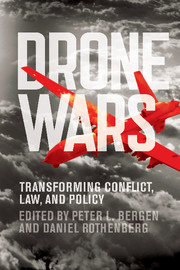Book contents
- Frontmatter
- Contents
- Contributors
- Acknowledgments
- Introduction
- Part I Drones on the Ground
- Part II Drones and the Laws of War
- 6 It Is War at a Very Intimate Level
- 7 This Is Not War by Machine
- 8 Regulating Drones
- 9 A Move Within the Shadows
- 10 Defending the Drones
- Part III Drones and Policy
- Part IV Drones and the Future of War
- Index
- References
7 - This Is Not War by Machine
Published online by Cambridge University Press: 05 December 2014
- Frontmatter
- Contents
- Contributors
- Acknowledgments
- Introduction
- Part I Drones on the Ground
- Part II Drones and the Laws of War
- 6 It Is War at a Very Intimate Level
- 7 This Is Not War by Machine
- 8 Regulating Drones
- 9 A Move Within the Shadows
- 10 Defending the Drones
- Part III Drones and Policy
- Part IV Drones and the Future of War
- Index
- References
Summary
Addressing Misconceptions about RPAs
There are a number of misconceptions about the use of remotely piloted aircraft (RPAs) as a weapons system by the US military. Some commentators focus excessively on RPAs’ role in attacking targets when, in fact, this is a less critical element of the platform’s innovation and value. Others suggest that RPAs place humans outside of the conflict and lead us toward “push-button warfare,” some new machine-driven vision of combat, when their actual use involves large teams of professionals engaged with the impact of war in a very direct and detailed manner. Still others suggest that the use of RPAs is illegal and runs counter to established domestic and international norms. These and other positions are based on core misunderstandings about the main value of RPAs, their complex role within integrated military actions, and the ways in which these platforms are transforming conflict.
The United States Air Force (USAF) use of RPAs has been largely confined to the conflicts in Afghanistan and Iraq. Despite the fact that many RPA pilots are not themselves in Afghanistan or Iraq, it is important to note that these RPAs are always utilized in a manner that integrates into a broader military strategy. In the major theaters of operation, the US Army, Marines, Navy, and Air Force are engaged in a joint fight under a joint commander running the fight plan. Every day, the air operation plan, which addresses use of the MQ-1 (the Predator) and MQ-9 (the Reaper) as part of a larger set of air assets, is in turn integrated with the larger joint fight. RPA capabilities are factored into the overarching theater campaign plan, and, as with other assets, RPA support is provided in response to requests by land and sea forces to achieve campaign objectives.
- Type
- Chapter
- Information
- Drone WarsTransforming Conflict, Law, and Policy, pp. 118 - 128Publisher: Cambridge University PressPrint publication year: 2014
References
- 1
- Cited by



